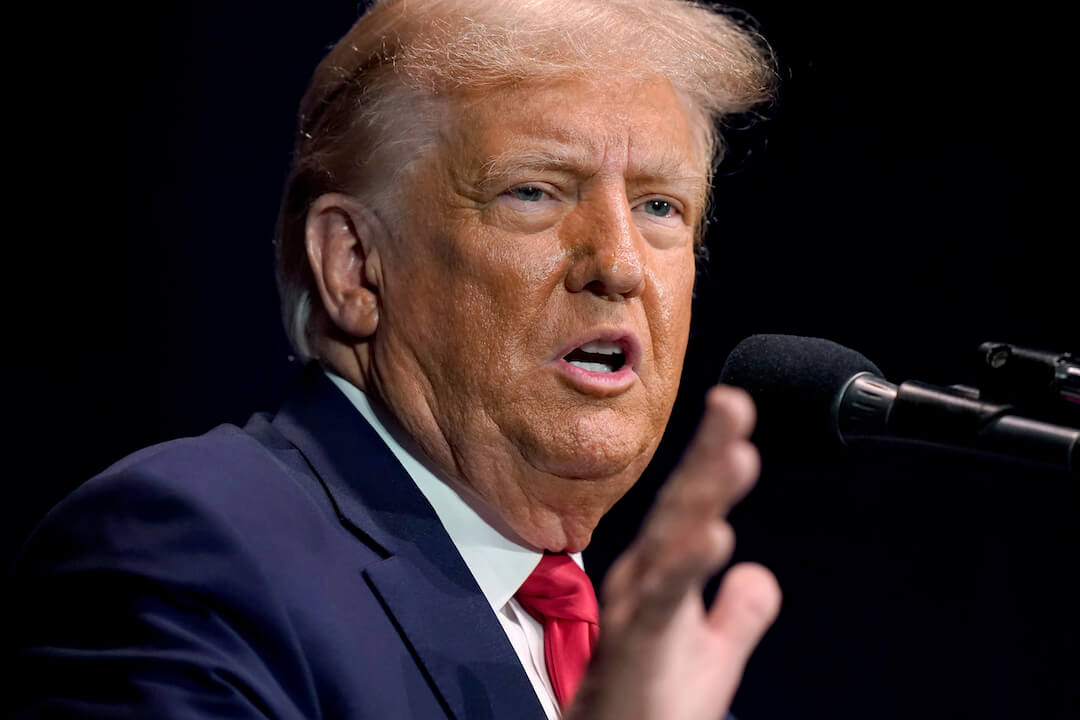Speaking to supporters in New Hampshire, former President Donald Trump blamed President Joe Biden for Hamas’ attacks in Israel and asserted that New Hampshire — and the nation — were far better off under his administration.
“The attack on Israel would never ever have happened. The attack on Ukraine … inflation would never have happened. None of it would have happened,” Trump said Oct. 9 at Kingswood Arts Center in Wolfeboro. “We would have been a different country.”
We can’t rate Trump’s hypothetical boasts on our Truth-O-Meter. But working with PolitiFact partner WMUR-TV, we fact-checked several of Trump’s statements, including his claims about New Hampshire drug overdoses, Hamas and the U.S. southern border wall.
Trump is the front-runner in polls measuring his appeal in a crowded field of Republican competitors.
Claim: One of the reasons Israel was attacked by Hamas was that Biden gave “$6 billion in ransom money” to Iran.
The role that a recent U.S.-Iran hostage agreement may have played in the Oct. 7 attack in Israel is in dispute. But experts say that Biden’s critics, and his administration in its own defense, make legitimate points.
In August, the U.S. announced an agreement with Iran to secure freedom for five U.S. citizens who’d been detained in the country. In exchange, the U.S. allowed Iran to access $6 billion of its own funds that had been frozen in South Korean banks since 2019. The money consisted of Iranian oil revenues.
Biden administration officials said in multiple TV appearances that the deal could not have hastened or aided the Oct. 7 attack because the money hasn’t been dispersed to Iran yet. Also, they said, the agreement required that Iran only use the funds for humanitarian items, such as medicine and food. But Biden’s critics counter that money is fungible, meaning that the money could be diverted to fund terrorism or simply free up money elsewhere in the Iranian government’s budget to be spent for non-humanitarian needs.
“If you had a large end-of-year bonus payment coming your way, might you start spending more money in the meantime? Of course. Money is fungible,” said Matthew Kroenig, a Georgetown University professor of government and foreign service.
Still, experts added that whatever support Iran might be providing Hamas would almost certainly have occurred with or without the hostage deal.
Despite having some reservations about the merits of the hostage agreement, “I don’t see any tangible connection between the $6 billion and this Hamas war,” said Matthew Levitt, a senior fellow at the Washington Institute for Near East Policy, a think tank that focuses on the Middle East.
“Iran was already spending significant funds on Hamas and Hezbollah (another Iranian-backed terrorist group based in Lebanon) before this deal,” Levitt said. For years, Iran’s government has “prioritized supporting militant and terrorist proxies over providing services for its own people,” he said.
Claim: “We did 561 miles of wall and we had another 200 that we ordered.”
Trump overcounted the number of miles of border barriers built under his administration and undercounted the additional miles he secured funding for but didn’t build.
A U.S. Customs and Border Protection report says Trump built barriers along 458 miles, not 561. In the majority of those miles, smaller and dilapidated barriers were replaced and did not add to the total miles of barriers along the southern border.
Brand new border wall covered 52 miles, by comparison.
Experts and observers, however, have said that Trump’s work replacing barriers shouldn’t be discounted. In many cases the new 30-foot steel barriers meant to stop pedestrians replaced 4-foot barriers intended to stop vehicles, the libertarian Cato Institute’s David Bier wrote in a 2022 report.
According to CBP figures, the Trump administration secured funding for an additional 280 miles of border barriers that it did not build.
Claim “Under my administration, we reduced drug overdose deaths in New Hampshire by 19% … under Biden they are up over 15%”
We found some similar numbers, but this lacks context.
Statistics from the New Hampshire medical examiner show that there were 490 drug deaths in 2017, Trump’s first year in office and 417 in 2020 — approximately a 15% decrease.
The number of drug deaths rose to 463 in 2022, an 11% rise from 2020.
New Hampshire had a Republican governor since January 2017 and a Republican legislature for much of that time.
Dr. Andrew Kolodny of Brandeis University, an opioid policy expert, said the vast majority of the opioid deaths occur in people who were addicted many years before they died.
“I don’t believe Trump deserves any credit for the slight dip during a portion of his administration,” Kolodny said.
Fentanyl has been flowing into the U.S. steadily since late in the Obama administration, Kolodny said, so it is inaccurate to characterize fentanyl as a Biden administration problem. Kolodny criticized all three administrations — Obama, Trump and Biden — for failing to devise a long-term funding stream to make it easier for people to get drug treatment.
Congressional funding has come in one- to two-year appropriations, which Kolodny said is not sufficient for states to build out treatment systems to expand access.
We found that nationally the drug overdose death rate dropped in 2018 but went up during three of Trump’s four years in office.
Chris Stawasz, spokesperson for AMR, the emergency medical services provider for Nashua and Manchester, has been tracking overdoses since 2016. He said he doesn’t know of a clear explanation for the overdose fall during Trump’s tenure. “That’s the million dollar question,” he said.
Claim: “Under my leadership, we had no inflation.”
This needs context. Inflation was lower under Trump than it has been under Biden. Until the COVID-19 pandemic hit, inflation hovered around 2%, just as it had for much of Obama’s presidency. In recent years, the Federal Reserve, the chief federal entity charged with keeping prices stable, has considered 2% its target for inflation. That goal was largely met under Trump.
Nevertheless, inflation never hit zero during his presidency. It neared that in April 2020 and May 2020, but that was when the pandemic started and the economy was in free-fall.
Under Biden, the inflation rate hit a 40-year high in summer 2022 at 9.1%, but has since slid to 3.7%.
Economists say that Biden’s American Rescue Plan, the coronavirus and economic relief bill passed early in his tenure, may have exacerbated inflation but did not create it.
Claim: The United States was “energy independent three years ago.”
Data shows that the U.S. has made gains in U.S. energy independence in recent years, but it still has a way to go to reach full energy independence. By three measures — net energy exports, net petroleum exports and greater domestic production than domestic consumption — the U.S. achieved a degree of energy independence during the Trump years.
Although the U.S. produces enough crude oil to satisfy its consumption, the U.S. cannot refine all of the crude oil it produces, experts say.
Many U.S. refineries cannot process the type of oil produced here, called “light” and “sweet.” U.S. refineries are built to process heavier, less sweet crude (also called heavy, sour crude) from the Middle East and other overseas suppliers. That’s a holdover from past decades, when the U.S. was primarily importing its crude.
This mismatch keeps the U.S. from simply using its own crude production to serve domestic needs. And by continuing to rely on crude oil imports, the U.S. is far from “independent” of developments overseas. For example, in April 2020, Trump was in high-stakes negotiations with Russian President Vladimir Putin and Saudi Crown Prince Mohammed bin Salman over oil production.
Claim: New Hampshire pays “the highest energy costs, anywhere in the country.”
Hawaii has the highest energy costs, but New Hampshire came in second, according to a report released earlier this year by SunPower, a solar company.
“Although the cost of residential electricity is approximately 13 cents per kilowatt-hour cheaper than in Hawaii, the New Hampshire average of 32.32 cents per kilowatt-hour is higher than all other states, exceeding the U.S. average by over 190%,” the report said.
SunPower examined the total average cost of residential electricity in cents per kilowatt-hour as of September 2022 from the U.S. Energy Information Administration (EIA) Electric Power Monthly.
Trump promised to bring down energy costs in New Hampshire and said he will “rescind every Green New Deal catastrophe of the Biden administration.” The Green New Deal was a resolution, which is nonbinding and not actual legislation, and was voted down in the Senate in 2019. It was reintroduced in the House in April but is not expected to pass.
Claim: “Bacon has gone up five times … in the last year and a half.”
This is False.
At its peak under Biden, the price of bacon rose by 30%, not the 400% that it would be if Trump’s “five times” comment was correct.
After a subsequent decline in price, the increase during Biden’s presidency now stands at 11.5%. Today’s level is just 2% higher than its peak under Trump.
David L. Ortega, Michigan State University associate professor in the Department of Agricultural, Food and Resource Economics, told PolitiFact that “fluctuations in bacon or pork prices in general have nothing to do with who is president.”
Claim: “The Trump administration gave you .. the biggest tax cuts … in the history of our country.”
This is False.
In inflation-adjusted dollars, the Tax Cuts and Jobs Act of 2017 is the fourth-largest since 1940. And as a percentage of GDP, it ranks seventh.
Claim: “When I left office, we had (the gasoline price) all the way down to $1.99 a gallon.”
Gas prices dipped below $2 during the Trump administration — during the pandemic. National average gasoline prices fell to $1.79 in May 2020, when much economic activity, commuting and travel stopped.
When Trump left office — as the pandemic was easing — average gasoline prices were higher, $2.38. And over the course of his presidency, the price averaged $2.46.
Experts say key reasons gasoline prices have been higher under Biden are the return to economic normalcy, which increased demand, and the war in Ukraine, which led Western nations to limit their purchases of Russian oil, constraining supply, at least temporarily.
PolitiFact Reporter Samantha Putterman contributed to this report.
This fact check was originally published by PolitiFact, which is part of the Poynter Institute. See the sources for this fact check here.










